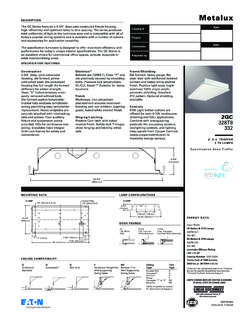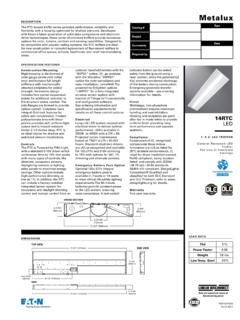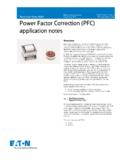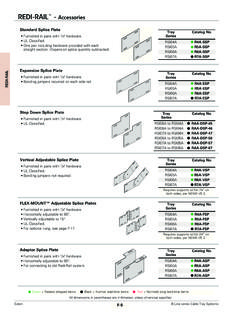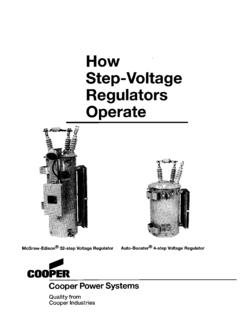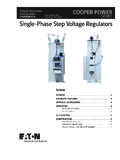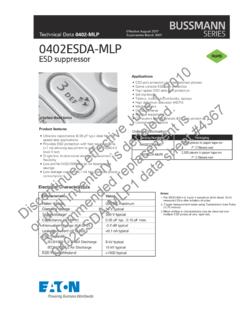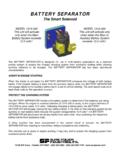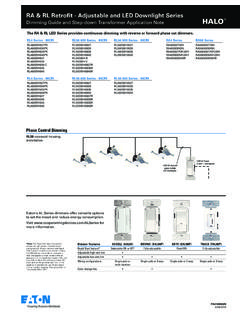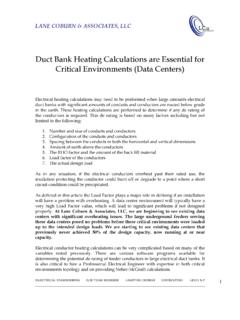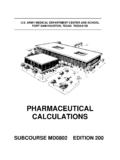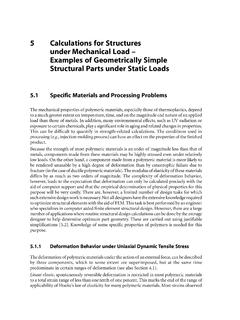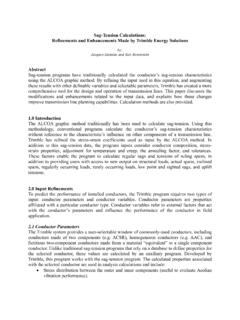Transcription of Short Circuit Current Calculations - Cooper Industries
1 Short Circuit Current Calculations Introduction Several sections of the National Electrical Code relate to proper overcurrent pro- Normally, Short Circuit studies involve calculating a bolted 3-phase fault condition. This tection. Safe and reliable application of overcurrent protective devices based on can be characterized as all 3-phases bolted together to create a zero impedance these sections mandate that a Short Circuit study and a selective coordination study connection. This establishes a worst case (highest Current ) condition that results in be conducted.
2 These sections include, among others: maximum three phase thermal and mechanical stress in the system. From this calculation , other types of fault conditions can be approximated. This worst case condi- Interrupting Rating tion should be used for interrupting rating, component protection and selective coordina- Component Protection tion. However, in doing an arc-flash hazard analysis it is recommended to do the arc- Conductor Protection flash hazard analysis at the highest bolted 3 phase Short Circuit condition and at the Equipment Grounding Conductor Protection minimum bolted three-phase Short Circuit condition.
3 There are several variables in a Marked Short - Circuit Current Rating; distribution system that affect calculated bolted 3-phase Short - Circuit currents. It is - (3) Meter Disconnect important to select the variable values applicable for the specific application analysis. In - Industrial Control Panels the Point-to-Point method presented in this section there are several adjustment factors - (B) Air Conditioning & Refrigeration Equipment given in Notes and footnotes that can be applied that will affect the outcomes. The - (A) Industrial Machinery variables are utility source Short Circuit capabilities, motor contribution, transformer per- Selective Coordination cent impedance tolerance, and voltage variance.
4 - Health Care Facilities - Selective Coordination - Essential Electrical Systems In Healthcare Systems In most situations, the utility source(s) or on-site energy sources, such as on-site - Selective Coordination for Elevator Circuits generation, are the major Short - Circuit Current contributors. In the Point-to-Point method - Emergency Systems presented in the next few pages, the steps and example assume an infinite available - Legally Required Standby Systems Short - Circuit Current from the utility source. Generally this is a good assumption for Compliance with these code sections can best be accomplished by conducting a highest worst case conditions and since the property owner has no control over the Short Circuit study as a start to the analysis.
5 The protection for an electrical system utility system and future utility changes. And in many cases a large increase in the utility should not only be safe under all service conditions but, to insure continuity of available does not increase the Short - Circuit currents a great deal for a building system service, it should be selectively coordinated as well. A coordinated system is one on the secondary of the service transformer. However, there are cases where the actual where only the faulted Circuit is isolated without disturbing any other part of the utility medium voltage available provides a more accurate Short Circuit assessment system.
6 Once the Short Circuit levels are determined, the engineer can specify (minimum bolted Short - Circuit Current conditions) that may be desired to assess the arc- proper interrupting rating requirements, selectively coordinate the system and flash hazard. provide component protection. See the various sections of this book for further When there are motors in the system, motor Short Circuit contribution is also a very information on each topic. important factor that must be included in any Short - Circuit Current analysis. When a Short Low voltage fuses have their interrupting rating expressed in terms of the Circuit occurs, motor contribution adds to the magnitude of the Short - Circuit Current .
7 Symmetrical component of Short - Circuit Current . They are given an RMS running motors contribute 4 to 6 times their normal full load Current . In addition, series symmetrical interrupting rating at a specific power factor. This means that the fuse rated combinations can not be used in specific situations due to motor Short Circuit can interrupt the asymmetrical Current associated with this rating. Thus only the contributions (see the section on Series Ratings in this book). symmetrical component of Short - Circuit Current need be considered to determine For capacitor discharge currents, which are of Short time duration, certain IEEE (Institute the necessary interrupting rating of a low voltage fuse.)
8 For listed low voltage fuses, of Electrical and Electronic Engineers) publications detail how to calculate these interrupting rating equals its interrupting capacity. currents if they are substantial. Low voltage molded case Circuit breakers also have their interrupting rating Procedures and Methods expressed in terms of RMS symmetrical amps at a specific power factor. However, To determine the fault Current at any point in the system, first draw a one-line it is necessary to determine a molded case Circuit breaker's interrupting capacity in diagram showing all of the sources of Short - Circuit Current feeding into the fault, as order to safely apply it.
9 See the section Interrupting Rating vs. Interrupting Capacity well as the impedances of the Circuit components. in this book. To begin the study, the system components, including those of the utility system, now requires arc-flash hazard warning labeling on certain equipment. A. are represented as impedances in the diagram. flash hazard analysis is required before a worker approaches electrical parts that have not been put into a safe work condition. To determine the incident energy and The impedance tables include three-phase and single-phase transformers, cable, flash protection boundary for a flash hazard analysis the Short - Circuit Current is and busway.
10 These tables can be used if information from the manufacturers is not typically the first step. readily available. It must be understood that Short Circuit Calculations are performed without General Comments on Short Circuit Calculations Current -limiting devices in the system. Calculations are done as though these Sources of Short - Circuit Current that are normally taken under consideration include: devices are replaced with copper bars, to determine the maximum available . - Utility Generation - Local Generation Short - Circuit Current .
